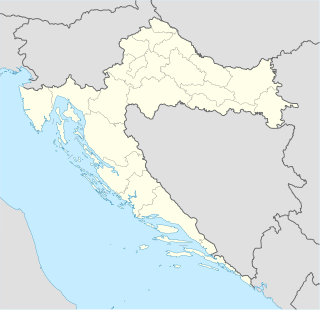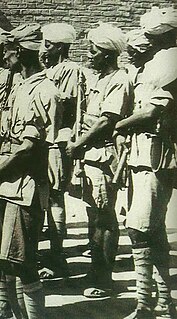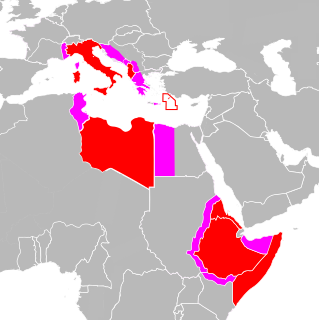 W
WThe military history of Italy chronicles a vast time period, lasting from the overthrow of Tarquinius Superbus in 509 BC, through the Roman Empire, Italian city-states, Italian unification, and into the modern day. The Italian peninsula has been a centre of military conflict throughout European history: because of this, Italy has a long military tradition. Today Italy is the 8th country by Military Strength Index.
 W
WThe Airmobile Brigade "Friuli" is an airmobile brigade of the Italian Army, based mainly in the Emilia-Romagna region. The brigade was part of the 1st Defence Forces Command until it was transferred to the Division "Friuli". The brigade's coat of arms depicts a stylized version of the Rocca di Monfalcone castle near the city of Monfalcone in the Friuli region, where the brigade distinguished itself during World War I. Since 1 July 2019 the brigade is part of the Division "Vittorio Veneto".
 W
WPietro Badoglio, 1st Duke of Addis Abeba, 1st Marquess of Sabotino, was an Italian general during both World Wars and the first viceroy of Italian East Africa. With the fall of the Fascist regime in Italy, he became Prime Minister of Italy.
 W
WBands was in Italian military term for irregular forces, composed normally of foreigners or natives, with some Italian officers and NCOs in command. These units were employed by the Italian Army as auxiliaries to the regular national and colonial military forces. They were also known to the British colonial forces as "armed Bands".
 W
WThe Bersaglieri Brigade "Garibaldi" is a mechanized infantry brigade of the Italian Army, based in the south of the country. Its core units are Bersaglieri, an elite infantry corps of the Italian Army. The brigade is named after Giuseppe Garibaldi a hero of the Italian wars of unification. The brigade is part of the Division "Acqui".
 W
WThe Cavalieri Addobbati, also known as Cavalieri di Corredo, were the elite among Italian knights in the Middle Ages. The two names are derived from addobbo, the old name for decoration, and corredo, meaning equipment. These were knights who could afford elaborate clothes, armor and equipment for themselves, their charger and their palfrey.
 W
WThe Challenge of Barletta was a duel fought in the countryside of Trani, near Barletta, southern Italy, on 13 February 1503, on the plains between Corato and Andria.
 W
WThe Cima Vallona ambush was a double improvised explosive device attack on Italian security forces at Cima Vallona, Provincia di Belluno. The ambush was carried out on 26 June 1967 by members of the South Tyrolean Liberation Committee, a paramilitary organization seeking the independence of German-speaking South Tyrol from Italy. The first explosion, involving the use of a landmine, struck a patrol of Alpini from the Italian Army, called in after the bombing of an electricity pylon. A second patrol, this time composed by Carabinieri, bore the full blast of a booby-trap while searching the area of the previous attack. One Alpini and three Carabinieri were killed, while a fourth Carabiniere survived with serious injuries.
 W
WDubat(Arabic: العمائم البيضاء ; ḍubbāṭ: English: White turban) was the designation given to members of and the armed irregular bands employed by the Italian "Royal Corps of Colonial Troops" in Italian Somaliland from 1924 to 1941. The word dubat was derived from a Somali phrase meaning "white turban".
 W
WThe Etruscans, like the contemporary cultures of Ancient Greece and Ancient Rome had a persistent military tradition. In addition to marking the rank and power of certain individuals in Etruscan culture, warfare was a considerable economic boon to Etruscan civilization. Like many ancient societies, the Etruscans conducted campaigns during summer months; raiding neighboring areas, attempting to gain territory and combating piracy as a means of acquiring valuable resources such as land, prestige goods and slaves. It is also likely individuals taken in battle would be ransomed back to their families and clans at high cost. Prisoners could also potentially be sacrificed on tombs to honor fallen leaders of Etruscan society, not unlike the sacrifices made by Achilles for Patroclus.
 W
WThe 1992 European Community Monitor Mission helicopter downing was an incident that occurred on 7 January 1992, during the Croatian War of Independence, in which a European Community Monitor Mission (ECMM) helicopter carrying five European Community (EC) observers was downed by a Yugoslav Air Force Mikoyan-Gurevich MiG-21, in the air space above the village of Podrute, near Novi Marof, Croatia. An Italian and a French officer and three Italian non-commissioned officers were killed. Another ECMM helicopter flying in formation with the attacked helicopter made an emergency landing. The second helicopter carried a crew and a visiting diplomat, all of whom survived. The incident was condemned by the United Nations Security Council and the EC. As a result of the incident, the Yugoslav authorities suspended the head of the air force, and the Yugoslav defense minister, General Veljko Kadijević, resigned his post. The events followed the end of the first stage of the war in Croatia and closely preceded the country's international recognition.
 W
WA field mill, also known as a camp mill, was a premodern vehicle which acted as a mobile mill used for grinding grains, which had the very practical use of feeding a moving army.
 W
WThe Fort Lawton riot refers to a series of events in August 1944 starting with a violent conflict between U.S. soldiers and Italian prisoners of war at Fort Lawton in Seattle, Washington during World War II. After the riot, prisoner Guglielmo Olivotto was found dead. This led to the court-martial of 43 soldiers, all of them African Americans.
 W
WGiuseppe Maria Garibaldi was an Italian general, patriot and republican. He contributed to the Italian unification and the creation of the Kingdom of Italy. He is considered to be one of the greatest generals of modern times and one of Italy's "fathers of the fatherland", along with Camillo Benso, Count of Cavour, Victor Emmanuel II of Italy and Giuseppe Mazzini. Garibaldi is also known as the "Hero of the Two Worlds" because of his military enterprises in South America and Europe.
 W
WThe Gastone Sozzi Centuria was a Communist unit raised in Barcelona by Italian and Catalan volunteers who, at the beginning of the Spanish Civil War, went to the defence of Madrid, besieged by the Rebel Army. The name of the unit was in honour to Italian communist Gastone Sozzi, assassinated in 1928 by camicie nere, of Fascist orientation.
 W
WThe Italian African Police, was the police force of Italian North Africa and Italian East Africa from 1 June 1936 to 1 December 1945.
 W
WThe Italian campaigns of the French Revolutionary Wars (1792–1802) were a series of conflicts fought principally in Northern Italy between the French Revolutionary Army and a Coalition of Austria, Russia, Piedmont-Sardinia, and a number of other Italian states.
 W
WThe Italian nuclear weapons program was an effort by Italy to develop nuclear weapons in the late 1960s and early 1970s. Italian scientists, like Enrico Fermi and Edoardo Amaldi had been at the forefront of the development of nuclear weapons in the United States, but rejected the technology at the end of the Second World War. After abortive proposals to establish a multilateral program with NATO Allies in the 1950s and 1960s, Italy launched a national nuclear weapons program. The country converted the light cruiser Giuseppe Garibaldi and developed and tested a ballistic missile called Alfa. The program ended in 1975 upon Italy's accession to the Non-Proliferation Treaty. Currently, Italy does not produce or possess nuclear weapons but takes part in the NATO nuclear sharing program, hosting B61 nuclear bombs at the Aviano and Ghedi Air Bases.
 W
WThe Italian Volunteer Legion also known as the Italian Scouts were an expatriate military unit which took part in the Anglo-Boer War, raised and led by soldier and adventurer Camillo Ricchiardi on behalf of General Louis Botha.
 W
WThe Malga Sasso bombing was a major bomb attack on an Italian Guardia di Finanza outpost not far from the Brennero pass, in the Province of Bolzano, near the border with Austria. The attack was carried out on 9 September 1966 by members of the South Tyrolean Liberation Committee (BAS), a paramilitary organization seeking the independence of German-speaking South Tyrol from Italy. Two guards were killed by the blast on the spot, while a third died of wounds several days later. Three others were seriously injured. The separatist militants Alois Larch, Alois Rainer and Richard Kofler were prosecuted and sentenced by the Italian Justice in 1976.
 W
WThe War of the Mantuan Succession (1628–31) was a peripheral part of the Thirty Years' War. Its casus belli was the extinction of the direct male line of the House of Gonzaga in December 1627. Brothers Francesco IV (1612), Ferdinando (1612–26) and Vincenzo II (1626–27), the last three dukes of Mantua from the direct line, had all died leaving no legitimate heirs. The war, fought among the backers of rival claimants, pitted France against the Habsburgs in a contest for control of northern Italy.
 W
WThe March of the Iron Will was an Italian Fascist propaganda event staged from 26 April to 5 May 1936, during the final days of the Second Italo-Ethiopian War. The goal of the march was to capture the Ethiopian capital in a show of force. An Italian mechanized column under the command of Pietro Badoglio, Marshal of Italy, advanced from the town of Dessie to take Addis Ababa. The march covered a distance of approximately 200 miles (320 km).
 W
WThe Mechanized Brigade "Granatieri di Sardegna" is a mechanized infantry brigade of the Italian Army, based in Rome and central Italy. The brigade fields one of the oldest regiments of the Army and is one of the guard regiments of the President of Italy. The name of the unit dates back to the Kingdom of Sardinia and not the eponymous Mediterranean island of Sardinia. The brigade is part of the Division "Acqui".
 W
WThe Multinational Force in Lebanon (MNF) was an international peacekeeping force created in August 1982 following an 1981 U.S.-brokered ceasefire between the PLO and Israel to end their involvement in the conflict between Lebanon's pro-government and pro-Syrian factions. The ceasefire held until June 3, 1982 when the Abu Nidal Organization attempted to assassinate Shlomo Argov, Israel's ambassador to London. Israel blamed the PLO and three days later invaded Lebanon. West Beirut was besieged for seven weeks before the PLO acceded to a new agreement for their withdrawal. The agreement provided for the deployment of a Multinational Force to assist the Lebanese Armed Forces in evacuating the PLO, Syrian forces and other foreign combatants involved in Lebanon's civil war.
 W
WThe 2003 Nasiriyah bombing was a suicide attack on the Italian Carabinieri MSU headquarters in Nasiriyah, Iraq, south of Baghdad on 12 November, 2003. The attack resulted in the deaths of 18 Italian servicemembers, mostly members of the MSU Carabinieri, an Italian civilian, and 9 Iraqi civilians and was the worst Italian military disaster since the Second World War. The attack, labeled a "terrorist act" by Italian president Carlo Azeglio Ciampi, was among a string of many attacks on non-American military international targets in Iraq that occurred shortly after the end of major combat operations, including the Jordanian and Turkish embassies, International Red Cross, and UN facilities.
 W
WFilippo Negroli was an armourer from Milan. He was renowned as being extremely skilled, and may be considered the most famous armourer of all time. Working together with his younger brothers Giovan Battista and Francesco in the Negroli family workshop headed by their father Gian Giacomo Negroli, Filippo was specialized in repoussé of armour, whereas his brother Francesco was renowned for his damascening skills. Filippo's pieces are considered especially remarkable because they were wrought in steel, rather than the more-easily worked iron that was the traditionally assumed medium.
 W
WThe naval Battle of Ostia took place in 849 in the Tyrrhenian Sea between Muslim pirates and an Italian league of Papal, Neapolitan, Amalfitan, and Gaetan ships. The battle ended in favor of the Italian league, as they defeated the pirates. It is one of the few events to occur in southern Italy during the ninth century that is still commemorated today, largely through the walls named after Leo and for the Renaissance painting Battaglia di Ostia by Raphael.
 W
WThe Quadrilatero is the traditional name of a defensive system of the Austrian Empire in the Lombardy-Venetia region of Italy, which connected the fortresses of Peschiera, Mantua, Legnago and Verona between the Mincio, the Po and Adige Rivers. The name refers to the fact that on a map the fortresses appear to form the vertices of a quadrilateral. In the period between the end of the Napoleonic Wars and the Revolutions of 1848, they were the only fully modernized and armed fortresses within the Empire.
 W
WThe Roman expansion in Italy covers a series of conflicts in which Rome grew from being a small Italian city-state to be the ruler of the Italian peninsula. Roman tradition attributes to the Roman kings the first war against the Sabines and the first conquests around the Alban Hills and down to the coast of Latium. The birth of the Roman Republic after the overthrow of the Etruscan monarch of Rome in 509 BC began a series of major wars between the Romans and the Etruscans. In 390 BC, Gauls from the north of Italy sacked Rome. In the second half of the 4th century BC Rome clashed repeatedly with the Samnites, a powerful tribal coalition of the Apennine region. By the end of these wars, Rome had become the most powerful state in central Italy and began to expand to the north and to the south. The last threat to Roman hegemony came during the Pyrrhic war when Tarentum enlisted the aid of the Greek king Pyrrhus of Epirus to campaign in the South of Italy. Resistance in Etruria was finally crushed in 265-264 BC, the same year the first punic war began and brought Roman forces outside of the peninsula for the first time.
 W
WThe Royal Corps Of Eritrean Colonial Troops were indigenous soldiers from Eritrea, who were enrolled as askaris in the Royal Corps of Colonial Troops of the Royal Italian Army during the period 1889–1941.
 W
WThe Salt War of 1540 was a result of an insurrection by the city of Perugia against the Papal States during the pontificate of Pope Paul III. The principal result was the city of Perugia's definitive subordination to papal control.
 W
WSkanderbeg's Italian expedition (1460–1462) was undertaken to aid his ally Ferdinand I of Naples, whose rulership was threatened by the Angevin Dynasty. George Kastrioti Skanderbeg was the ruler of Albania who had been leading a rebellion against the Ottoman Empire since 1443 and allied himself with several European monarchs in order to consolidate his domains. In 1458, Alfonso V of Aragon, ruler of Sicily and Naples and Skanderbeg's most important ally, died, leaving his illegitimate son, Ferdinand, on the Neapolitan throne; René d'Anjou, the French Duke of Anjou, laid claim to the throne. The conflict between René's and Ferdinand's supporters soon erupted into a civil war. Pope Calixtus III, of Spanish background himself, could do little to secure Ferdinand, so he turned to Skanderbeg for aid.
 W
WThe Turkish War of Independence was fought between the Turkish National Movement and the Allied powers – namely Greece in the West, Armenia on the East, France on the South, royalists and the separatists in various cities, and the United Kingdom and Italy in Constantinople – after parts of the Ottoman Empire were occupied and partitioned following the Ottomans' defeat in World War I.
 W
WThe Vlora War or the War of 1920 was a series of battles between Italian forces garrisoned throughout the Vlorë region of Albania and Albanian nationalists, who were divided into small groups of fighters. The war lasted three months until an armistice; it had great impact in the struggle of Albania for the safeguard of its territories while Albanian borders and future were discussed in the Paris Peace Conference. The Vlora War is seen as a turning point in the establishment of Albanian independence.
 W
WThe War of the Polish Succession was a major European conflict sparked by a Polish civil war over the succession to Augustus II of Poland, which the other European powers widened in pursuit of their own national interests. France and Spain, the two Bourbon powers, attempted to test the power of the Austrian Habsburgs in western Europe, as did the Kingdom of Prussia, whilst Saxony and Russia mobilized to support the eventual Polish victor. The fighting in Poland resulted in the accession of Augustus III, who in addition to Russia and Saxony, was politically supported by the Habsburgs.
 W
WThis article is about Italian military operations in World War I.
 W
WThe participation of Italy in the Second World War was characterized by a complex framework of ideology, politics, and diplomacy, while its military actions were often heavily influenced by external factors. Italy joined the war as one of the Axis Powers in 1940, as the French Third Republic surrendered, with a plan to concentrate Italian forces on a major offensive against the British Empire in Africa and the Middle East, known as the "parallel war", while expecting the collapse of British forces in the European theatre. The Italians bombed Mandatory Palestine, invaded Egypt and occupied British Somaliland with initial success. However, German and Japanese actions in 1941 led to the entry of the Soviet Union and United States, respectively, into the war, thus ruining the Italian plan of forcing Britain to agree to a negotiated peace settlement.